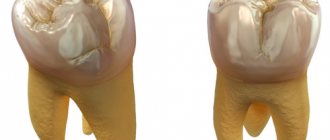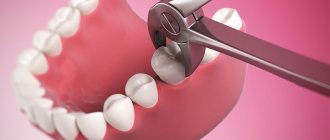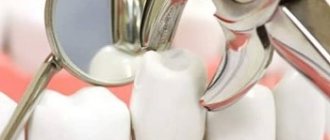Indications for removal
The dentist decides whether or not to remove a tooth, adequately assessing the situation in the mouth.
Direct indications are:
- advanced caries that cannot be treated;
- lack of a crown, with roots not suitable for implantation;
- crown fracture exposing the pulp;
- the dental unit is a source of infection, as a result of which complications develop (tonsillitis, periostitis, sinusitis, osteomyelitis of the jaw, abscess and phlegmon of the cheek);
- unsuccessful treatment of periodontitis;
- unerupted or incompletely erupted teeth are the cause of frequent inflammation, damage to nearby tissues and teeth;
- severe mobility with an extreme degree of periodontal damage that cannot be treated;
- purulent periodontitis, which is not relieved by conservative methods;
- crowding of teeth.
Complex removal of an upper wisdom tooth
As part of this procedure, drills are used, and the gingival tissue is dissected and the dental socket is sutured. Swelling after such removal of the upper wisdom tooth is considered a normal manifestation. The reason for this operation is the eruption of the tooth in a horizontal position, under a layer of bone tissue.
Procedure steps:
- Initially, the site of future intervention is anesthetized.
- The gum is dissected and part of it is peeled off using a scalpel.
- A hole is created in the bone tissue. In this case, special tips and cutters are used to provide a cooling effect.
- Full or partial extraction is performed.
- The dental alveolus is thoroughly washed with an antiseptic solution.
- The bone wound undergoes plastic surgery, and the detached part of the gum is returned to its place.
- Suturing the alveolar cavity and stopping bleeding.
After implementing all the sequential steps and removing the upper wisdom tooth, the specialist makes recommendations regarding further care.
Contraindications
- acute diseases of the cardiovascular system;
- high blood pressure numbers;
- infectious processes in the body;
- menstruation period in women, since blood clotting time is increased, which threatens bleeding after extraction;
- acute, severe diseases of the central nervous system;
- pregnancy, lactation period;
- purulent-septic processes in the oral cavity, which provokes sepsis; mental disorders.
The possibility of extracting a diseased tooth appears after treatment of these pathologies and stabilization of the patient’s condition. In case of an emergency, the doctor performs removal in a patient with concomitant diseases. Severe pain syndrome is the cause of exacerbation of chronic pathology.
Removal of a completely destroyed upper wisdom tooth
If a patient has a completely destroyed wisdom tooth, removal of the upper molar becomes inevitable, since it becomes painful for the person to chew food. Unfortunately, not every specialist can cope with such a situation. Sometimes the “eight” has to be removed in parts, which requires a significant investment of time and painstaking work of an experienced surgeon.
First of all, this is due to the difficulties that arise when trying to fix a tooth with forceps. In this case, it may be necessary to dissect the gum tissue. In particularly difficult situations, it may be necessary not only to crush hard tissue, but also to saw through the bone in order to free access to the root part of the tooth.
Such surgical intervention is best performed in patients no younger than 40 years of age, since it is during this period that the alveolus undergoes atrophy.
Removal techniques
The dental surgeon determines the extraction tactics individually for each patient. Takes into account the location of the tooth, the type of pathological process, and the degree of spread. Before extraction, the doctor sends the patient for an x-ray. The goal is to obtain accurate information about the roots and structural features of adjacent teeth and the jaw apparatus in which the pathological unit is located.
Simple operation
In the case of a conventional location, removal occurs in a simple way, which takes no more than 10 minutes, taking into account the effect of anesthesia. The dental surgeon performs the operation according to the following scheme:
- a preliminary survey of the patient about allergies to anesthesia drugs, chronic pathologies and the medications he uses;
- administration of a drug for superficial sedation in order to normalize the mental state and ensure a comfortable extraction process (at the request of the patient or according to indications);
- injection of a local anesthetic into nearby tooth tissues (gums, cheek), usually using ultracaine, which is considered hypoallergenic;
- after 4-5 minutes, the surgeon begins the removal process by loosening the tooth in the surrounding tissues;
- after ensuring mobility, the specialist separates the tooth from the gum and with a sharp movement turns it out of the alveolar socket;
- the wound is treated with an antiseptic solution;
- a tampon with a medicinal substance is applied to the wound, after which the bleeding stops for several minutes;
- if after tooth extraction the wound surface is too large, the doctor will apply several stitches, which will prevent the possibility of postoperative infection and bleeding in the future;
- the patient receives recommendations and goes home after stabilizing his physical and emotional condition.
After removal using a simple method, the patient feels well. If the wound bothers you after the anesthesia wears off, it can be easily eliminated by following your doctor's recommendations.
The hard way
When the doctor sees abnormalities on the x-ray, removal will be carried out in a complex way. The experience and skill of the doctor matters.
Stages in complex removal:
- taking anamnesis;
- choice of anesthesia;
- mandatory administration of sedatives to relieve tension in the patient;
- injection of local anesthesia into 5-6 areas surrounding the tooth to be removed;
- the doctor makes an incision in the gum to access the tooth and roots;
- drilling into several parts using a drill for easy removal and prevention of injury;
- the tooth is separated from the gum in parts and removed;
- a mandatory revision of the resulting hole is performed;
- the wound is treated with an antiseptic and sutured;
- To prevent infection and bleeding, the doctor places a drug or PRP membrane in the wound. They dissolve along with the sutures.
Extraction during the normal course of the process takes 20-30 minutes. If the operation is complicated, the procedure may take up to 2 hours. After a complex removal, the wound is wider, the tissue is more traumatized, the pain is more pronounced and lasts longer.
It is important that removal is carried out carefully, taking into account future implantation. Therefore, it is better to entrust the operation to an experienced maxillofacial surgeon who will not damage the alveolar ridge. In this case, you will not have to build up bone tissue before installing the implant and eliminate possible complications. Average surgeons usually do not stand on ceremony during operations. The result is broken bone structures of the jaw, wandering remnants of roots, unremoved cysts growing into the maxillary sinus, perforations, fistulas, osteomyelitis and much more. Not to mention the shocking post-operative pain that overtakes the patient after such punitive surgery. Only the maxillofacial surgeon has enough theoretical and practical skills to perform tooth extraction without complications.
Simple removal of wisdom teeth in the upper jaw
When performing the above procedure, the need to use a scalpel and dissect the gums is eliminated. Most often in this situation they resort to the help of a special surgical instrument - an elevator, or standard hand forceps.
Such removal of the upper wisdom tooth, as evidenced by reviews, is performed when there are no obstacles to removing the tooth from the socket:
- The root of the tooth is of medium length, without curvature;
- The “eight” protrudes onto the gums, which makes it possible to remove it with forceps;
- The tooth is single-rooted, or it has several roots fused into one.
To facilitate the extraction procedure, the specialist uses forceps with an S-shaped bend. If an upper wisdom tooth, significantly destroyed by caries, is removed, they resort to bayonet instruments, which are considered universal for carrying out this kind of manipulation. The latter have cheeks with a pointed shape, which have the ability to close and firmly hold the tooth roots.
Algorithm of surgical intervention:
- Applying the instrument to a figure eight crown.
- Immersion of the cheeks under the gum tissue covering the neck of the tooth.
- Advance the forceps to the desired depth and fix them on the tooth.
- Loosening of the unit in the buccal direction and its dislocation (luxation).
- Extraction of a wisdom tooth from the alveolar socket (traction).
To stop bleeding, the surgeon quickly applies a gauze pad to the sore area. As a rule, the duration of the procedure does not exceed 10 minutes.
Price
The cost depends on the technology used:
| Name of service | Price |
| Easy removal | 13,500 rub. |
| Difficult removal | 23,000 rub. |
The case includes:
- anesthesia;
- operation;
- removal and application of sutures.
Additional services:
| Name of service | Price |
| Sedation (per hour) | 12,000 rub. |
| Consultation with existing x-ray examination | 2,000 rub. |
| Consultation and X-ray diagnostics (CT scan in our Center on disk) | 5,200 rub. |
| Sight shot | 500 rub. |
Free consultation
Our specialists will conduct a free consultation and select the best treatment option for you.
Sign up now! Online registration
+7 (495) 649-41-19
Content
1 Is it easier to remove a wisdom tooth in the lower or upper jaw?
2 In what situations is it necessary to remove a wisdom tooth in the upper jaw?
3 Anesthesia for removal of the upper wisdom tooth
4 Simple removal of wisdom teeth in the upper jaw
5 Difficult removal of the upper wisdom tooth
6 Removal of a completely destroyed upper wisdom tooth
7 Is it painful to remove a wisdom tooth in the upper jaw?
8 Consequences after removal of the upper wisdom tooth
9 Recommendations for recovery after removal of the upper wisdom tooth
10 Prices for wisdom tooth removal in the upper jaw
Recommendations after surgery
- Do not eat or drink water for 6-7 hours after surgery;
- reduce physical activity, avoid visiting saunas and swimming pools for 4-5 weeks to prevent the development of bleeding;
- take analgesics to relieve pain in the early period;
- regularly take antibiotics prescribed for a course of 7 days;
- rinse your mouth with an antiseptic solution after eating;
- follow a gentle diet, avoid solid and irritating foods;
- stop smoking - nicotine provokes bleeding.
Following the doctor's recommendations reduces wound healing time and prevents the development of complications.
Anesthesia for removal of the upper wisdom tooth
As a rule, before extracting the “eight”, they resort to local painkillers - injections with articaine, lidocaine and other drugs with a similar spectrum of action. The dentist makes 2 injections - from the side of the palate and on the outside of the upper jaw. This allows you to obtain a powerful anesthetic effect, which manifests itself within 2-5 minutes after administration.
In the case of the eighth tooth, located in the mandibular region, at least 9-10 minutes are required due to the increased bone density in this area.
However, the pain syndrome can make itself felt within 2-3 hours after surgery, which requires additional use of painkillers and anti-inflammatory drugs.
How long does it take for a wound to heal?
Normally, the wound surface heals in 4-5 weeks. In older patients, healing is delayed due to decreased tissue repair and reduced blood circulation.
The rate of healing depends on the extent of the procedure and the roots. In the case of complex removal of a molar with 3-4 roots, the process of tissue regeneration is delayed up to 20-25 days.
Restoration of gum tissue goes through the following stages:
- in the first days, the wound is closed by a blood clot (thrombus), formed as a result of stopping the bleeding;
- 3-4 days after removal, the thrombus resolves, and new tissue appears on the surface of the wound in the form of a thin film;
- bone tissue forms on the sides of the socket already at 3 weeks;
- after 3-6 months, the hole heals and has no differences with the jaw bone.
The speed of wound healing after removal depends on the characteristics of the body and the age of the patient. If necessary, the doctor corrects the tissue regeneration process with medications and physiotherapeutic methods.
When there is a need for removal
Orthodontic treatment is required for patients who have a significant discrepancy between the sizes of teeth and jaws: for existing teeth of a certain size, there is simply not enough space on one, and sometimes on two jaws at once. Because of this, pathology of tooth placement develops:
- their crowding, manifested in partial overlap with each other;
- or protrusion - when narrower tooth roots fit on the jaw, and wide crowns can only stand straight if they protrude forward.
To restore the correct position of the teeth and eliminate the discrepancy in size with a “tight” jaw, dentists have to reduce the number of teeth before installing braces.
Is it possible to get braces without removing teeth ? It is possible, but in this case they can simply transform the problem of crowding into a problem of protrusion, and the aligned teeth, after removing the structure, will eventually return to their previous position.
Prices for wisdom tooth removal in the upper jaw
| Service | Price, ₽. |
| Surgeon consultation | for free |
| Carpule anesthesia (Ultracaine, Septanest, Ubistezin, Alfacain, Mepivastezin) | 500 |
| Application anesthesia of the mucous membrane (Lidocaine) | 150 |
| Removal of a tooth of increased complexity (wisdom teeth 1.8 2.8) | 3300 |
| Removal of impacted dystopic wisdom tooth | 5500 |
| Removal of lower wisdom tooth | 3000 |
| Removal of the lower wisdom tooth (advanced) | 4000 |
| Pocket cut | 500 |
The cost of this service may be influenced by: the complexity of the problem and the rating of the chosen dentistry. For example, the cost of an x-ray examination can reach 300-500 rubles. With a simple removal of the upper wisdom tooth, the price can be equal to 3500-7000 rubles. In turn, if a complex procedure is planned, be prepared to pay at least 4,000-9,000 rubles.
The Elident clinic has fixed an acceptable cost for such services - 3300-5500 rubles (depending on the complexity of the case).
Article expert (author):
Consequences after removal of the upper wisdom tooth
Often, after the removal of upper impacted wisdom teeth, serious consequences become apparent, including:
- Injury to the oral cavity or soft tissues, which is caused by improper placement of the “eight”;
- If the damage is severe, a fracture of the root or crown part is possible. This is accompanied by an uncharacteristic crunch;
- Dislocation of an adjacent unit. If excessive force is applied or an inexperienced specialist participates in the procedure, nearby teeth may be damaged;
- Breaking off a piece of a tooth root. This occurs due to the instruments gripping the tooth too deeply;
- Alveolitis. It appears when the necessary rules of care are ignored or in the presence of chronic inflammatory processes, or when parts of the tooth are not fully extracted from the socket;
- Damage to the lower part of the maxillary cavity. One of the most severe complications.










